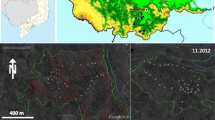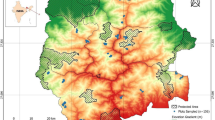Abstract
The adequate protection and sustainable management of a tropical rain forest requires a good knowledge of its biodiversity. Although considerable parts of Guyana's North-West District have been allocated as logging concessions, little has been published on the forest types present in this region. The present paper reviews the floristic composition, vegetation structure, and diversity of well-drained mixed and secondary forests in northwest Guyana. Trees, shrubs, lianas, herbs and hemi-epiphytes were inventoried in four hectare plots: two in primary forests, one in a 20-year-old secondary forest and one in a 60-year-old secondary forest. The primary forests largely corresponded with the Eschweilera–Licania association described by Fanshawe, although there were substantial variations in the floristic composition and densities of dominant species. The late-succession forest contained the highest number species and was not yet dominated by Lecythidaceae and Chrysobalanaceae. There is a need for updating the existing vegetation maps of northwest Guyana, as they were based on limited information. Large-scale forest inventories may provide a fair indication of species dominance and forest composition, but do not give a reliable insight in floristic diversity. Although previous reports predicted a general low diversity for the North-West District, the forests plots of this research were among the most diverse studied in Guyana so far. These results will hopefully influence the planning of protected areas in Guyana.
Similar content being viewed by others
References
Aide TM,Zimmerman JK,Rosario M andMercano H (1996) Forest recovery in abandoned cattle pastures along an elevational gradient in Northeastern Puerto Rico. Biotropica 28: 537–548
Alder D andSynott TJ (1992) Permanent sample plot techniques for mixed tropical forest. Tropical Forestry Papers 25, Oxford Forestry Institute, Department of Plant Sciences, University of Oxford, Oxford
Andel TR van (2000) Non-Timber Forest Products of the North-West District of Guyana. Part I and II. Tropenbos-Guyana Series 8A and 8B. Utrecht University, Utrecht, The Netherlands
Anderson CW (1912) The forests of the North-West District of the country of Essequibo. Forests of British Guiana, Detail reports, Series 1. Department of Lands and Mines, Georgetown, Guyana
Atkinson H (1990) The history of the Catholic Church in Santa Rosa in the North-West District of Guyana: 1817-1990. Amerindian Research Unit, University of Guyana, Georgetown, Guyana
Balée W (1994) Footprints of the Forest: Ka'apor Ethnobotany-The Historical Ecology of Plant Utilization by an Amazonian People. Colombia University Press, New York
Boom BM (1986) A forest inventory in Amazonian Bolivia. Biotropica 18: 287–294
Comiskey JA,Aymard G andDallmeijer F (1994) Structure and composition of lowland mixed forest in the Kakwani region of Guyana. Biollania 10: 13–28
Connel JH andLowman MD (1989) Low-diversity tropical rain forests: some possible mechanisms for their existence. The American Naturalist 134: 88–119
Cottam G andCurtis JT (1956) The use of distance measures in phytosociological sampling. Ecology 47: 451–460
Dallmeijer F andComiskey JA (eds) (1998) Forest Biodiversity in North, Central and South America, and the Caribbean: research and monitoring. MAB Digest. 21. UNESCO, Paris
Davis TAW (1929) Some observations on the forests of the North-West District. The Agricultural Journal of British Guiana 11: 157–167
Davis TAW andRichards PW (1934) The vegetation of Moraballi Creek, British Guiana: an ecological study of a limited area of tropical rain forest, Part II. Journal of Ecology 22: 106–155
Edinburgh Center for Tropical Forests (ECTF) (1995) Second annual report on its Programme of Monitoring and Research for the Barama Company Ltd. North West Guyana Sustainable Timber Production Programme, Georgetown, Guyana
Ek RC (1990) Index of Guyana plant collectors. Flora of the Guianas. Supplementary Series 1. Koeltz Scientific Books, Koenigstein, Germany
Ek RC (1997) Botanical diversity in the Tropical Rain Forest of Guyana. PhD thesis, Utrecht University. Tropenbos-Guyana Series 4, Tropenbos Foundation, Wageningen, The Netherlands
Ek RC andter Steege H (1998) The flora of the Mabura Hill area, Guyana. Botanisher Jahrbucher der Systematik 120: 461–502
Fanshawe DB (1949) Glossary of Arawak names in Natural History, British Guiana. International Journal of American Linguistics 15: 57–74
Fanshawe DB (1952) The Vegetation of British Guiana: a preliminary review. Institute Paper No. 29, Imperial Forestry Institute, University of Oxford, Oxford
Fanshawe DB (1954) Forest Types of British Guiana. Caribbean Forester 15: 73–111
Ferreira LV andPrance GT (1999) Ecosystem recovery in terra firme forests after cutting and burning: a comparison on species richness, floristic composition and forest structure in the Jaú National Park, Amazonia. Botanical Journal of the Linnean Society 130: 97–110
Fisher AA,Corbet AS andWilliams CB (1943) The relation between the number of species and the number of individuals in a random sample of an animal population. Journal of Animal Ecology 12: 42–58
Forest Industries Development Survey (FIDS) (1970) Forest type map of the North-West District inventory area. Government of Guyana, United Nations Development Programme, Guyana Forest Department and Food and Agriculture Organisation of the United Nations, Georgetown, Guyana
Gentry AH andDodson CH (1987) Contribution of non-trees to species richness of a tropical rain forest. Biotropica 19: 149–156
Hall P andBawa K (1993) Methods to assess the impact of extraction of non-timber tropical forest products on plant populations. Economic Botany 47: 234–247
Hammond DS andter Steege H (1998) Propensity for fire in Guianan rainforests. Conservation Biology 12: 944–947
Hart TB (1990) Monospecific dominance in tropical rain forests. Trends in Ecology and Evolution 5: 6–11
Hout P van der (1999) Reduced impact logging in the tropical rain forest of Guyana: ecological, economic and silvicultural consequences. PhD thesis, Utrecht University. Tropenbos-Guyana Series 6, Tropenbos Foundation, Wageningen, The Netherlands
Huber O (1995) Vegetation. Chapter 3. In: Steyermark JA,Berry PE andHolst BK (eds) Flora of the Venezuelan Guayana 1, pp 97–160. Missouri Botanical Garden, St Louis, Missouri
Huber O,Gharbarran G andFunk V (1995) Vegetation Map of Guyana: preliminary version. Centre for Study of Biological Diversity, University of Guyana, Georgetown, Guyana
Huston MA (1994) Biological Diversity: the coexistence of species in changing landscapes. Cambridge University Press, Cambridge
Johnston M and Gillman M (1995) Tree population studies in low-diversity forests, Guyana. I. Floristic composition and stand structure. Biodiversity and Conservation 4: 339–362
Martin GJ (1996) Ethnobotany. A methods manual. WWF, UNESCO and Royal Botanic Gardens, Kew. Chapman & Hall, London
Nasir N,Funk V,Waldron N andFamolare L (1997) Biodiversity and land-use information for the Guyana National Protected Area System study. Centre for the Study of Biological Diversity, University of Guyana and Conservation International-Guyana, Georgetown, Guyana
Persaud D (1997) Policies, legislation and organisational structure for protected areas in Guyana. In: Hoosein M (ed) Guyana National Report, pp 2–5. Environmental Protection Agency, Georgetown, Guyana
Philips OL,Hall P,Gentry AH,Sawyer AS andVasquez R (1994) Dynamics and species richness of tropical rain forests. Proceedings of the National Academy of Sciences, USA 91: 2805–2809
Ramdass I (1990) A definition of priority conservation areas in Amazonia. Guyana Country Paper. Conservation International, Manaus, Brazil Schomburgk R ( 1848) Reisen in Britisch Guiana in den Jahren 1840-1844, Teil II. Leipzig
Sizer N (1996) Profit without plunder: reaping revenue from Guyana' tropical forests without destroying them. World Resources Institute, Washington, DC
Steege H ter (1993) Patterns in tropical rain forest in Guyana. PhD thesis, Utrecht University. Tropenbos Series 3, Tropenbos Foundation, Wageningen, The Netherlands
Steege H ter (1998) The use of forest inventory data for a National Protected Area Strategy in Guyana. Biodiversity and Conservation 7: 1457–1483
Steege H ter (2000) Plant Diversity in Guyana. Tropenbos Series 18, Wageningen, The Netherlands
Steege H ter,Lilwah R,Ek RC,van der Hout P,Thomas R,van Essen J andJetten V (2000a) Composition and diversity of the rain forest in Central Guyana. Tropenbos-Guyana Reports 2000-1. Utrecht University, Utrecht, The Netherlands
Steege H ter,Jansen-Jacobs MJ andDatadin VK (2000b) Can botanical collections assist in a National Protected Area Strategy in Guyana? Biodiversity and Conservation 9: 215–240
Valkenburg JLCH van (1997) Non-Timber Forest Products of East Kalimantan: potentials for sustainable forest use. PhD thesis, Wageningen Agricultural University. Tropenbos Series 16, Tropenbos Foundation, Wageningen, The Netherlands
Wessels Boer JG (1965) The Indigenous Palms of Suriname. E.J. Brill, Leiden, The Netherlands
Williams D (1989) The Archaeic of north-western Guyana. History Gazette 7. University of Guyana, Georgetown, Guyana
Author information
Authors and Affiliations
Rights and permissions
About this article
Cite this article
van Andel, T. Floristic composition and diversity of mixed primary and secondary forests in northwest Guyana. Biodiversity and Conservation 10, 1645–1682 (2001). https://doi.org/10.1023/A:1012069717077
Issue Date:
DOI: https://doi.org/10.1023/A:1012069717077




